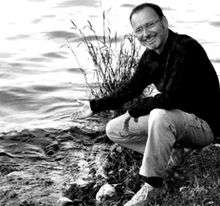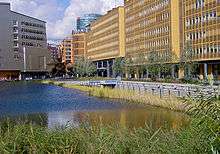Herbert Dreiseitl
Herbert Dreiseitl (born 1955) is a sculptor, artist, landscape architect and interdisciplinary urban planner. He founded the firm Atelier Dreiseitl (now: Ramboll Studio Dreiseitl) in 1980 with a vision for liveable cities inspired by a deep understanding of water.[1] Today Herbert has his own practice, DREISEITLconsulting, to advice cities and regions and is teaching at NUS in Singapore.
Herbert Dreiseitl | |
|---|---|
 Herbert Dreiseitl in 2010 | |
| Born | 16 March 1955 |
| Nationality | German |
| Occupation | Architect |
| Awards | Urban Edge Award, University of Wisconsin-Milwaukee USA (2011) Loeb Fellowship, Harvard University (2011) |
| Practice | Founder: Atelier Dreiseitl, now: Ramboll Studio Dreiseitl, Founder: Ramboll Liveable Cities Lab |
| Website | www |
His particular expertise is in combining artistic aspects with environmental planning and implementation with regards to water in an urban setting. His work is considered to be at the leading edge in urban hydrology and the treatment of waste and stormwater, realizing sustainable infrastructure, which combines city resource needs with space for nature and people.[1][2] To irrigate topics related to sustainable infrastructure he founded the Liveable Cities Lab in the Danish Ramboll Group, focusing on research and consultation. His rich experience is in great demand by cities around the world.
Herbert Dreiseitl has been described as "the international doyen of landscape design with water".[3]
Philosophy
For Dreiseitl, landscape architecture is more than plants, sidewalks, planters, and ponds.[4] His approach focuses more attention on water and its natural flow, not only as an aesthetic element, but by designing to incorporate effective water-management infrastructure and heeding its role as an important ecological and social tool.[5] The humanistic aspect of his approach is recognised and respected by his peers because of its visible results.[2]
Dreiseitl's philosophy has particularly come of age at the present time, where climate change and water supply have been put high on the agenda of key institutions such as the IMF, World Bank, Asian Development Bank and world governments[6][7] and are named as two of the top five global risks facing companies today. [8]
Life and career

Dreiseitl was born in Ulm, Germany, where he attended the Ulm Waldorf School.[9] He trained as an artist and did apprenticeships in England, Norway and Germany.[10] He was highly influenced by the philosophies of Rudolf Steiner, Hugo Kükelhaus and Joseph Beuys.
During his period of civil service, Dreiseitl initiated an art therapy program for young drug addicts, which was so successful that he continued for four years. Whilst there, he recognised that for young people, the urban environment is very important for liveability and public health. So he decided to work in public space to improve the conditions in cities.
His first major public work was an award-winning fountain for a new garden for the blind, designed by landscape architects Eppinger + Schmid. In preparation for his design, Dreiseitl met regularly with a group of interested blind people to better understand how they experience the world without sight.
After founding his studio Atelier Dreiseitl, Dreiseitl worked on his first stormwater management plan in 1981, celebrating and bringing water to the surface in a new suburb in Lausanne, Switzerland.[11]
Over the past 30 years, he has completed numerous projects with Atelier Dreiseitl, ranging from modest water features to large-scale water management systems, including Renzo Piano's Potsdamer Platz in Berlin, Norman Foster's McLaren Technology Centre in London and the SolarCity Linz, Austria.[5]
In 2011, Dreiseitl was appointed Loeb Fellow at the Graduate School of Design at Harvard University, becoming one of the few non-US citizens to have been accepted on the programme.[2] As a Loeb Fellow, Herbert explored the history of water and society, the changing exogenous water security environments, and design tools for managing global water-related risks.[12]
In April 2013, Dreiseitl merged Atelier Dreiseitl with the Ramboll Group.[13] Dreiseitl is helping to shape cities in many parts of the world to become more resilient by integrating blue and green structures even in dense urban spaces.
Herbert is a visiting professor at the National University of Singapore focusing on teaching and research. With his consultancy DREISEITLconsulting Herbert runs workshops and pilot projects to encourage cities to implement better solutions to current urban challenges.
Selected awards
- 2017 Fellow of ASLA, The American Society of Landscape Architects, Los Angeles
- 2016 Award of Excellence, ASLA, for Copenhagen Cloudburst Mitigation Plan
- 2016 Honor Award, The American Society of Landscape Architects (ASLA) for Bishan-Ang Mo Kio Park in Singapore
- 2015 President's Design Award Singapore, Jury Member, Singapore
- 2015 Reallabor Stadt, Research funding Jury Chair, Mannheim
- 2014 President's Design Award Jurong Eco-Garden, Singapore
- 2012 President's Design Award Bishan-Ang Mo Kio Park, Singapore
- 2012 WAF Landscape of the Year Kallang River Bishan- Ang Mo Kio Park, Singapore
- 2011 Urban Edge Award from University of Wisconsin-Milwaukee, USA
- 2011 Loeb Fellowship at the Graduate School of Design at Harvard University, USA
Publications
- Dreiseitl, H., (2018). In: Sustainable Nation – Urban Design Patterns for the Future, Douglas Farr, Wiley
- Dreiseitl, H. (2016). In: Sustainable Urbanism: Integrating Behavior, Neighborhoods, and Technology through Urban Design.
- Dreiseitl, H., (2016). In: Out of Water – With a foreword by Herbert Dreiseitl
- Dreiseitl, H., (2016). Dense + Green, Innovative Building Types for Sustainable Urban Architecture, Birkhäuser
- Dreiseitl, H., (2015). Liveable Cities; The Art of Integrating Today What We Need Tomorrow, Future Arch 2015
- Dreiseitl, H., (2018). Enhancing blue-green infrastructure and social performance in high-density urban environments. National University of Singapore, Harvard Graduate School of Design, MIT and Zeppelin University; funded by the Ramboll Foundation, 2013–2016
- Dreiseitl, H., Wanschura, B., Tovatt, D. O. (2015). Shaping Landscapes and Human Welfare. Comparative Field Study of the Non-Material Effects of Blue-Green Integration in Singapore. NUS, Singapore
- Dreiseitl, H., Leonardsen, J.A., Wanschura, B. (2015). Cost-Benefit Analysis of Bishan-Ang Mo Kio Park. National University of Singapore
- Dreiseitl, H., (2015). Blue-Green Infrastructure for Cities, EcoBuild Magazine TR 2015
- Dreiseitl, H., & Grau, D. (2014). Waterscapes Innovation. Design Media, UK. (ISBN 988-12-9693-5)
- Dreiseitl, H., Grau, D., & Ludwig, Karl H C. (2001) Waterscapes: Planning, Building and Designing with Water. Birkhäuser, Switzerland. (ISBN 3-7643-6508-0)
- Dreiseitl, H. Grau, D. (2005) New Waterscapes: Planning, Building and Designing with Water. Birkhäuser, Switzerland. (ISBN 3-7643-7476-4)
- Dreiseitl, H. Grau, D. (2009) Recent Waterscapes: Planning, Building and Designing with Water. Birkhäuser, Switzerland. (ISBN 978-3-7643-8984-0)
- Dreiseitl, H. Geiger, W F. Stemplewski, J (2010). Neue Wege für das Regenwasser. Oldenbourg Industrieverla. (ISBN 3-8356-3178-0)
Memberships
- Member and Fellow of the American Society of Landscape Architecture, FASLA Nr. 778625
- Member Architektenkammer NW (L 41 560) – German Architects Association
- Member ASLA – American Society of Landscape Architects
- Member VBKW – Württemberg Association of Visual Artists
- Member BBK – Professional Association of Visual Artists
- Member ATV-DVWK – German Association for Water Management, Wastewater and Waste
- Member SILA – Singapore Institute of Landscape Architects
See also
- Tanner Springs Park
- Bishan Park
- Sustainable city
- Green Infrastructure
- Water-sensitive urban design
- Sustainable urban drainage system
- Low-impact development (Canada/US)
- Liveable cities
- Climate change
- Resilient cities
- Urban resilience
References
- http://www.urbanparks2012.org/Speakers/herbert-dreiseitl/ accessed: 07.05.13
- http://www.nna-news.org/news/en/index.cgi/101015-02EN_DREISEITL-LOEB-FELLOW-HARVARD.html accessed: 29.05.13
- Richardson, Tim (2012). Viewpoint: Tim Richardson. Garden Design Journal, page 7.
- Yudelson, Jerry (2009). Green Building Trends: Europe. Washington DC: Island Press. ISBN 978-1-59726-477-8. Page 23.
- Buxton, Pamela (2002). Water on the Brain. Building Design, page 14–15.
- http://www.wri.org/event/2013/04/fostering-growth-and-poverty-reduction-world-immense-risk (video) accessed: 06.06.13
- http://www.adb.org/about/policies-and-strategies accessed: 06.06.13
- "Archived copy". Archived from the original on 2013-06-01. Retrieved 2013-06-06.CS1 maint: archived copy as title (link) accessed: 06.06.13
- http://www.anthromedia.net/en/news-details/article/herbert-dreiseitl-appointed-loeb-fellow-at-harvard-university/%5B%5D accessed: 07.05.13
- http://www.gardenvisit.com/biography/herbert_dreiseitl accessed: 29.05.13
- Brown, Brenda J (2001). Harvesting What You Can't Hold Tight. Landscape Architecture Magazine, page 98.
- http://www.gsd.harvard.edu/#/people/herbertdreiseitl.html accessed: 07.05.13
- http://www.ramboll.com/news/viewnews?newsid=87BDE1F3-1D7C-4049-B628-514078A0CF5B%5B%5D accessed: 29.05.13
External links
| Wikimedia Commons has media related to Herbert Dreiseitl. |